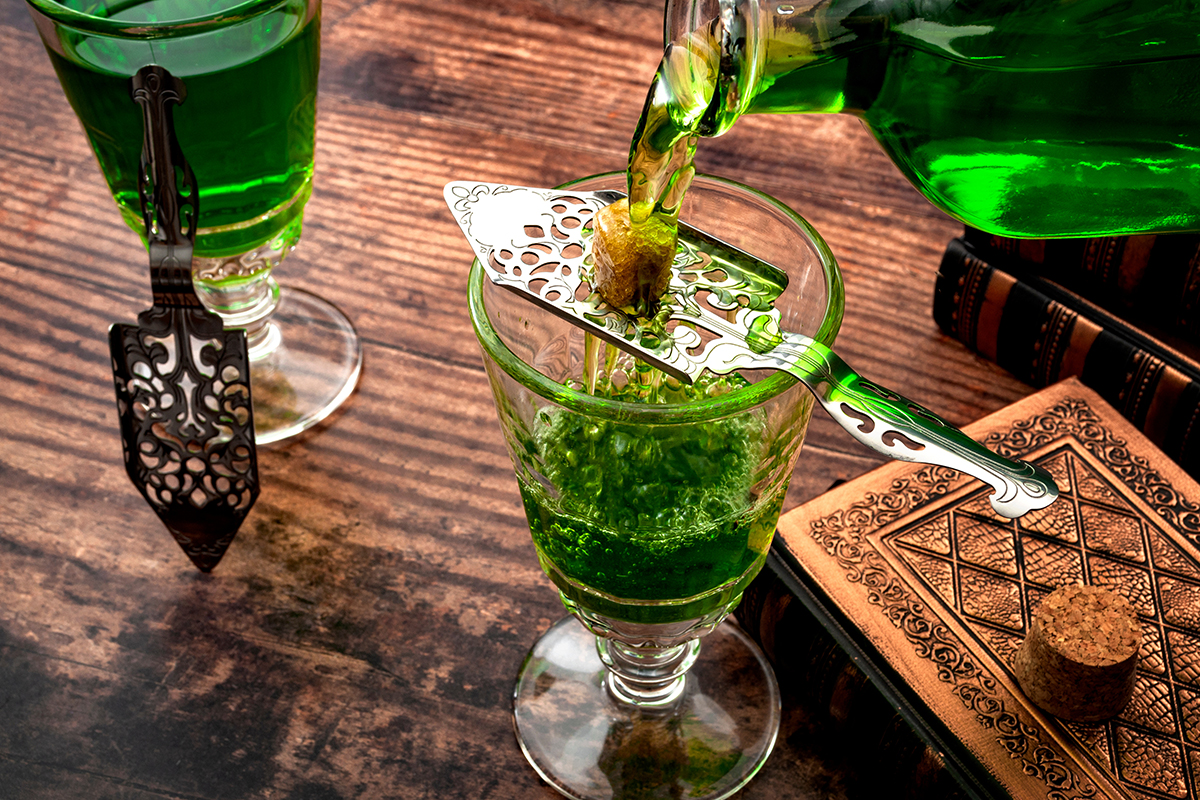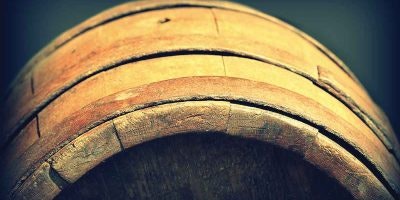No other drink has had such a mythology attached to it like absinthe. As a once illicit spirit, it seems that drinking absinthe will never escape appearing dangerous or forbidden. But for those seeking out hallucinations, they will be sadly disappointed when they don’t see the Green Fairy materialize after a few glasses. For the rest of us, we can be glad that we can once again enjoy the L’heure Verte—The Green Hour—to our hearts content.
A Brief History of Drinking Absinthe
Although drinking absinthe was at its height in the late 1800s during the Belle Époque in France, its use goes back to ancient Egypt when it was used for medicinal purposes. Modern-day absinthe dates to Switzerland where it was being produced commercially at the end of the 1700s. Its popularity grew in France in the 1830s after French soldiers came back from fighting in Algeria. There it was used as an antimalarial and was mixed with wine to make it palatable. When phylloxera, a vine disease, decimated the wine industry in the 1870s, its popularity grew as it was inexpensive and easy to produce using neutral spirit as a base.
During the Belle Époque, it was known to be the beverage of choice for many artists and poets of the time such as Van Gogh, Verlaine, Rimbaud, Manet, Wilde and Toulouse-Lautrec, among many others. It was served in French cafes, cabarets, bistros and music halls. It was served everywhere in France and parts of Europe and even New Orleaneans were drinking absinthe as it made its way across the pond.
However, the temperance movement—assisted by winemakers—targeted absinthe as the reason for society’s problems and wanted it banned. Shortly after the First World War began, it was outlawed in France (in the US it was banned in 1912). In fact, several other countries joined suit over the years. Spain and Czech Republic continued to produce and legally consume it, but much of the world forgot about absinthe.

Thujone
Fast-forward to the early 21st century, the laws regarding absinthe in the US were reinterpreted in 2007. In short, the law regarding Artemisia absinthium states that it must be thujone-free. But that does not mean zero thujone. In the US, that amount is ten parts per million or 10mg/L (the EU regulation is 35mg/L). Since most authentic absinthes have trace amounts of thujone in them, they are, and had been, legal to sell.
So what is thujone, you might ask? Thujone is a chemical compound found in a number of plants, but most famously it is found in Artemisia absinthium or grand wormwood. It is not a hallucinogen or psychedelic. Thujone was blamed for absinthe drinkers going mad during the height of its popularity. However, extreme alcoholism and unscrupulous producers were likely to blame. Still, this stigma stays with thujone and therefore absinthe.
Thujone offers up a menthol-like aroma and it’s toxic if consumed in large quantities. However, the amount of thujone found in wormwood is so small that you would die of alcohol poisoning before you would die of thujone poisoning. In fact, there is more thujone found in sage than there is wormwood and no one worries about its toxicity.
So What is Absinthe?
Absinthe is a distilled spirit flavored with aniseed, grande wormwood, and fennel—these botanicals are known as the “Holy Trinity”. Other botanicals are used for flavoring, but these three are required to be called true absinthe. Typically, the alcohol content is from 55-72% ABV and it’s intended to be consumed after dilution with cool/iced water.
Generally, absinthe begins life as a neutral spirit which can be made of any agricultural ingredient. Beets and grains are common ingredients used to make the neutral spirit. More often than not, this neutral spirit is purchased and not made by the absinthe producer. Then, the neutral spirit is infused with the aniseed, grande wormwood, and fennel along with any other botanicals if desired. After infusing, the spirit is re-distilled. This is important—you cannot just infuse botanicals into a spirit, bottle it and call it absinthe. You must re-distill it.
After it is re-distilled, the absinthe remains a clear spirit like other distilled spirits. At this point it can be bottled as is or reduced slightly with water. No sugar is added. If bottled clear, it is considered to be made in the Swiss-style also known as Blanche or Bleue. However, if after re-distillation the maker wants to achieve a green color, you would add herbs to macerate in the spirit. This is the French-style of absinthe, also known as Verte.
How to Serve Absinthe
As we mentioned, typically absinthe is bottled between 55-72% ABV. Therefore it is not intended to drink neat and it’s definitely not meant to be consumed as a shot. When drinking absinthe, it is recommended that you add cool or ice water to your glass. As to the ratio, anywhere from 3:1 to 5:1 water to absinthe is a good start, but this will be up to you. Consider the ABV, but start out with a 3:1 ratio and taste. If you find it too bitter, you can add a bit more water and/or you can add sugar.
By the way, adding sugar to your absinthe isn’t like adding sugar to your coffee or tea. You don’t just dump it in there. This is where the absinthe spoon comes in. It’s a decorative and flat utensil that allows you to place it right across the top of your glass, prior to adding the water. When ready for the water, add the sugar cube on top of the spoon and slowly drip or pour the water in your glass.
The Louche
There’s a ritual to be had when drinking absinthe. There is something to be said about very slowly adding water to the absinthe and watching the oils swirl in the glass. This “ouzo effect” will begin to happen with a cloudy haze beginning to form. What you’ll want to find is for the absinthe to have a milky, but opalescent appearance to it which you can better find in the daylight hours. How much weight you put into the appearance of the louche is up to you.
You may think that you need to buy an absinthe fountain and special glassware to fully appreciate the spirit. But you can enjoy it just fine with a standard water glass and a pitcher of ice water. And if you want to sweeten your absinthe with a sugar cube but don’t have an absinthe spoon, you can get away with using a fork instead.

Burning Absinthe—Not Traditional
As we mentioned before, absinthe is bottled at between 55-72% ABV. Therefore, it is extremely flammable. Traditional absinthe service eschews the fire ritual. However, there are some that enjoy this, particularly with Czech absinthe. These drinkers pour absinthe in a glass and then place the absinthe spoon on top of the glass. Then they douse the sugar cube with absinthe and place it on top of the spoon and light it. After the flame goes out, they stir the sugar in the absinthe and then pour ice water in the glass to dilute it.
This caramelization obviously changes the flavor and improves poorly made absinthe. But if you’re looking for the real experience, skip the fire.
Anise Liqueurs Are Not Absinthe
When absinthe was banned, anise-flavored liqueurs became popular replacements. These include pastis, ouzo, sambuca, anisette and raki (also known as arak and arrack) among others. Although these are flavored with aniseed (among other botanicals), they do not contain wormwood. More importantly, these liqueurs contain sugar which true absinthe does not. They are also sold at a much lower proof than absinthe. That said, they are a good introduction to the flavors of absinthe. If you don’t like anise, chances are you won’t enjoy drinking absinthe. Even so, do try again in a few years. Bitter flavors do grow on you as you age.
Ready to start drinking absinthe?
With Distiller, you’ll always know what’s in the bottle before you spend a cent. Rate, Review, and Discover spirits. Head on over to Distiller, or download the app for iOS and Android today!
Want to enjoy Distiller ad-free? Join Distiller Pro today to support the Distiller platform and keep ads off of your screen.


